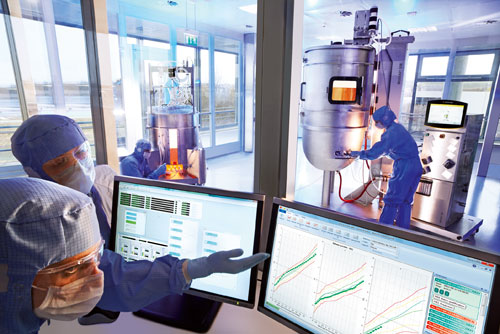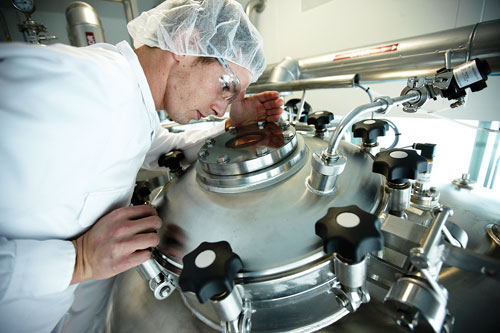June 15, 2014 (Vol. 34, No. 12)
Angelo DePalma Ph.D. Writer GEN
Best practices in upstream processing seek to maintain cell health and product quality during cell culture. “Each is irreversibly susceptible to its environment and deviations that result in loss in efficiency and yield,” says Mario Becker, director of marketing and product management at
Sartorius Stedim Biotech.
The goal of process analytic technology (PAT), therefore, is to monitor and control such factors as pH, dissolved oxygen, temperature, and nutrient level to produce more cells and product.
But as Becker points out, biomanufacturing has advanced to the point of complexity where controlling these factors within accuracy and precision goals has become more demanding. Concurrently, regulators continue to apply pressure, demanding tighter controls, greater understanding, and higher consistency. “Eventually, a ‘should’ becomes a ‘must,’” Becker continues. Therefore, each step of the process requires a level of PAT that is balanced between financial investment, legal implications, and profitability. “In the end, it is all about risk mitigation.”
Several multiuse sensor technologies within PAT are no longer considered PAT products; they have become mandatory. These include temperature, pressure, pH, dissolved oxygen, conductivity, flow rate, and basic molecular percentages. What is now considered PAT has shifted from offline sampled to inline or online methods. These include cell, nutrient, and metabolite concentrations and viability and spectroscopic measurements.
“From here, the established PAT status quo has been teetering on a related paradigm shift from stainless-steel to single-use processes,” Becker asserts. “The market now expects the sensors utilized in stainless-steel, multi-use systems to be fully integrated with and to function equivalently in single-use unit operations.”
And there, Becker says, lies the challenge to vendors: long-term planning must encompass a thorough understanding of market needs with respect to disposable systems. Key success factors include the availability of fully integrated single-use sensor and analytical technologies; local control and advanced automation capabilities; and ready-to-use bioreactors with integrated, automated glucose-feed control or integrated, real-time measurement of viable cell density for automated induction, infection, and harvesting routines.
“The leading adopters of single-use technology will pioneer the way into commercial manufacturing, but not without critical and extensive testing during process development,” Becker adds. This is currently under way at top biopharma companies, but also within small and mid-sized entities.

BioPAT® MFCS, SCADA software from Sartorius Stedim Biotech, used to control an upstream process.
New Method for Aggregates
Aggregation of therapeutic proteins plagues biomanufacturing from research through distribution. Although considered most problematic during post-formulation storage and distribution, aggregation may occur as early as expression, during cell culture or fermentation. Protein-drug conjugates as well as recombinant proteins and antibodies are susceptible. Causes include pH, ionic strength, protein concentration, freeze-thaw operations, temperature, and packaging materials and agents (such as glass and silicone oil).
Well-known techniques for characterizing protein aggregates are based on particle sizing methods such as dynamic light scattering (DLS), flow cell microscopy, and laser diffraction. “These methods are not always confirmative,” says Morgan Mathieu, applications scientist, Enzo Life Sciences. “Size-exclusion HPLC provides a bit more quantification, but it is not high throughput.”
Conventional particle-sizing methods rely on complex instrumentation as well. Data are often unintelligible to nonspecialists. Moreover these techniques do not readily distinguish between true protein aggregates and nonprotein particles of similar dimensions.
A technique from Enzo Life Sciences based on the company’s Proteostat® line of aggregation analysis kits and products uses a dye that is specific for protein aggregation. Assays are of “mix and read” simplicity, and quantification occurs in high-throughput mode in microplates using a fluorescence plate reader, an instrument found in nearly any laboratory.
Another protocol, based on a similar dye, measures the temperature of aggregation. Understanding this property—higher is better—is critical for specifying storage temperatures of biopharmaceuticals. It requires, in addition to the reagent kit, an instrument that precisely controls temperature, such as a fluorimeter with precise temperature control, or a polymerase chain reaction analyzer.
Aggregation assays rarely stand on their own as independent, confirmatory assays, as every approach measures a different underlying physical characteristic. According to Mathieu, “The general approach these days is to use orthogonal methods.”
Single-Use Standards Revisited
The rapid growth of single-use products in biomanufacturing has created the need for best practices and standards, which the Bio-Process Systems Alliance (BPSA) and BioPhorum Operations Group (BPOG) are addressing. Their activity includes engaging traditional standards bodies and test method developers, issuing a white paper on particulates, and harmonizing such topics as special terms, methods of control, and approaches to characterization.
But the idea of “standardization” in single-use bioprocessing still presents challenges. “Depending upon the audience and context, ambiguity exists regarding what aspects of the materials, assemblies or procedures ‘standardization’ refers to,” says William Whitford, senior technical market manager, GE Healthcare Life Sciences. “Furthermore, questions remain regarding its purposes and goals, its timing, and (importantly) its international scope and authority.”
Moreover, participants with different backgrounds have diverse ideas of what standardization might look like. Engineers think of it in terms of a formal ASTM Code or Technical Standard. Regulators may regard it as compliance, while others contemplate less formal best practices, guidelines, or benchmarks providing general guidance. Uncertainty also exists regarding the scope of application with any of these issues.
Arguments for standardization include the potential for smaller inventories, heightened component understanding, and reduced production set-up changes resulting in potentially lower costs through just-in-time deliveries from multiple vendors.
Yet debate even exists regarding the desirability of standards. Some end users would restrict accommodation of legacy requirements or of novel process designs, while vendors claim they will lose their competitive edge without the ability to customize their assemblies.
“It’s clear that de novo customization is slow and expensive, while tight regulations can be stifling to innovation,” Whitford explains. “However, platform approaches incorporating a baseline design plus a defined customization may be possible.” Top-down approaches have been proposed for standard product platforms that facilitate customization. These assemblies could accommodate many levels of commonality and multiple, highly defined custom specifications, an approach known as “guided configurability,” which Whitford says could provide the benefits of standardization from “supplier, lead-time, and cost perspectives, yet provide the flexibility of full customization.”
Roche has been active in scaledown technology for some time. Marco Jenzsch, Ph.D., director of fermentation in pharma biotech production at Roche Diagnostics, recently presented a talk on a 2 L scaledown system that accurately simulates a 12,000 L cell culture production reactor. According to Dr. Jenzsch, such factors as cell culture growth, metabolism, and product yield/quality were accurately reproduced in the smaller system.
Roche performs scaledown exercises on every new process for which process development and process characterization cannot be performed in final production scale due to cost, timelines, or asset availability. Typical scenarios include process validation studies for risk mitigation during tech transfers and scale-up of development-stage and mature processes); troubleshooting for performance use tests of critical raw materials (such as protein hydrolysates and complex chemically defined media components); and modeling for continuous improvements throughout the product lifecycle.
“Scaledown is essential for process development and the approval of NBEs, since the design space of a production process cannot be assessed with runs at the commercial scale from an economic and strategic perspective,” Dr. Jenzsch explains.
Some process parameters are easier to model in scaledown mode than others, which makes understanding the true rate-limiting events in the large bioreactor critical. For a particular process, this might be mass transfer of oxygen or carbon dioxide, mixing, or shear forces. Key to establishing a successful scale down model is mimicking the operating windows of the cells for all of these regimes in the small scale bioreactor.
Due to the nonlinear behavior of hydrodynamics, some unit operations in large bioreactors are difficult to maintain constant at 2 L bench scale. Constant volumetric power input (Watts/m3 or Watts/kg) is used as the first scaledown. Calculating agitation speed using constant volumetric power input implies sufficient mixing, comparable oxygen mass transfer, and similar shear conditions at small scale compared to the at-scale process. “Liquid mixing is usually not an issue in small-scale bioreactors, but where mixing is a limiting step at manufacturing scale, it may need to be reflected in the scaledown model,” Dr. Jenzsch continues.
The most difficult parameter to match is the profile of dissolved CO2 across scales. In contrast to oxygen mass transfer, CO2 stripping depends only on gas throughput in large scale, whereas at small scale power input contributes to CO2 mass transfer as well.
“A fundamental prerequisite for [achieving a successful scaledown model] is characterization of the installed equipment and knowledge of the equipments’ influence on unit operations and cell culture performance,” Dr. Jenzsch notes.
Matching all engineering parameters matters little if cells don’t behave similarly at small scale to large scale, or if product quality is significantly different. Going a step further, quality can differ even when cell growth and metabolism are similar.
Demonstrating product equivalence therefore becomes critical when scaledown data is used in regulatory filings. According to Dr. Jenzsch, recent filings suggest that regulators are taking a close look at scaledown models.

A technician at Roche inspects a mid-sized stainless-steel bioreactor.
Insect Cell Culture: Lack of Experience
FDA approval of Protein Sciences’ FluBlok®, a recombinant influenza vaccine produced in baculovirus-transfected insect cells, demonstrated the potential for this expression system. FluBlok consists of hemagglutinin, a viral surface protein, and uses Protein Sciences’ expressSF insect cell line.
But as Ma Sha, Ph.D., director of internal applications at Eppendorf, has noted, it took the sponsor 10 years to gain approval for its product. “Insect cell culture itself does not present too many difficulties,” says Dr. Sha. “In many ways, insect cell cultures are easier to grow than animal cultures. But new cell lines represent a tremendous regulatory challenge.”
For example, developers must reinvent the wheel with respect to safety of both drug and culture, whereas animal cell culture processes have platform safety protocols.
Because less work has been done with baculovirus, and barely any product approvals exist, companies considering insect cell expression systems have less to go by. “There’s a lot less information, and few scientists have worked with insect cells,” Dr. Sha adds. And even though culture media, reagents, bioreactors, and peripheral requirements are not as stringent as for CHO cultures, the lack of experience and information in these areas create an entry barrier for otherwise predisposed developers.
On the positive side, insect cells are remarkably robust and thrive in a variety of reactors, including stainless-steel and plastic, and in both batch and perfusion cultures. “Because of their simplicity, single-use platforms are common in insect cell work,” Dr. Sha explains.
As with CHO cultures, practice in insect cultures has a hard time keeping up with innovation. Protein Sciences has scaled its insect cell cultures up to 600 L in a stirred tank reactor, achieving approximately five to six million cells per milliliter. Eppendorf has recently demonstrated a spin-filter-based process—similar to continuous perfusion culture—that achieves up to 25 million cells per milliliter. “The yield improvement over batch culture is pretty dramatic for insect cells,” Dr. Sha asserts. “The technique essentially turns a batch culture into a perfusion culture.”







